|

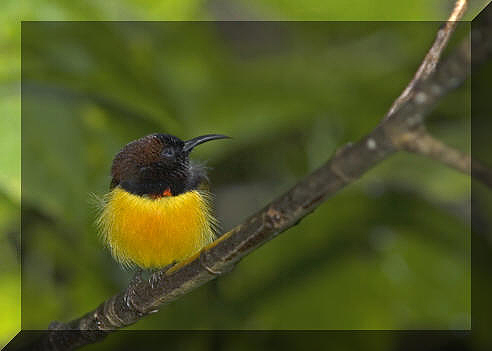
Flaming Sunbird (Gnistsolfugl); Balinsasayo Twin
Lakes, Negros
| |
|
Artslisten er forfattet av Rob
Hutchinson og først publisert på hjemmesiden til Bird Tour
Asia:
http://www.birdtourasia.com/philippinestour2007.html
Rapporten beskriver turen i
detalj og gir et svært godt inntrykk av en fantastisk
reise i et av verdens mest spennende fugleland.
Filippinene regnes som et av verdens viktigste reisemål
hvis man ute etter sjeldne endemer. Få andre land har en
så presset natur som Filippinene. Den gjenværende
regnskogen forsvinner i et skremmende høyt tempo. "It's
now or never!"
Den jevne filippiner er gjestfri og
svært trivelig. Mat og drikke kunne nytes uten alt for mye
redsel for sjau med fordøyelsessystemet. Hygienen er
utmerket, alt gikk ned - til og med råsalat - helt
problemfritt.
Thanks Rob! |
|
|
|
Litteratur:
| |
|
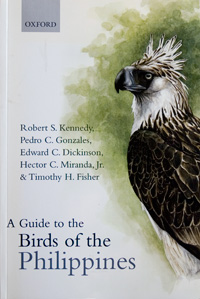 |
"A Guide to
the Birds of The Philippines"; Robert S. Kennedy, Pedro C.
Gonzales, Edward C. Dickinson, Hector C. Miranda Jr. & Timothy H.
Fisher.
En utmerket
felthåndbok med svært akseptable fargeplansjer og kortfattet tekst
samt informative utbredelseskart på motstående side. |
|
|
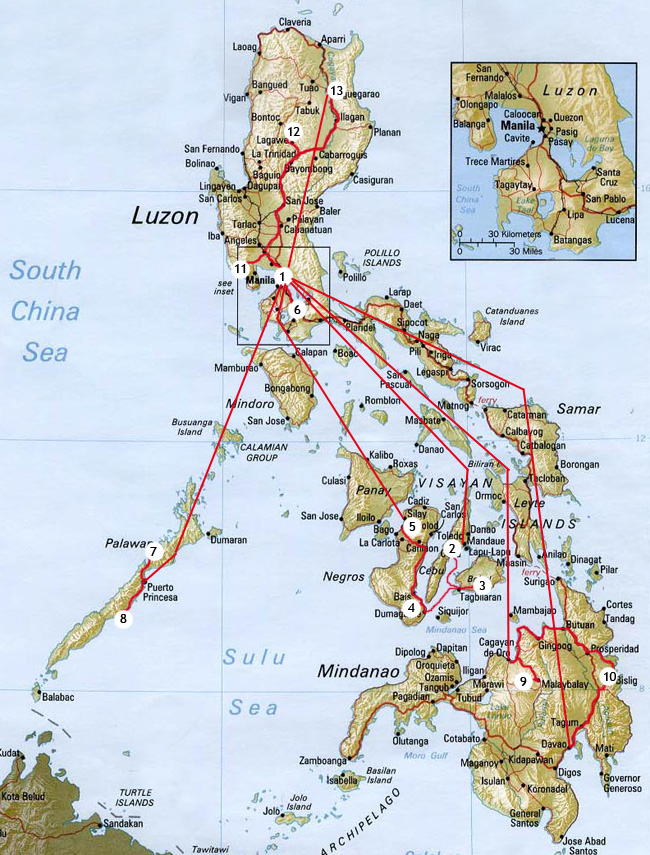
|
| |
1:
2:
3:
4:
5:
6:
7:
8:
9:
10:
11:
12:
13: |
|
Manila
Cebu
Bohol; Rajah Sikatuna National Park
Negros; Dumaguete & Balinsasayao Twin Lakes
Negros; Mt. Kanlaon & Mambucal
Luzon; Mt. Makiling
Palawan; Sabang & Saint Paul National Park
Palawan; Raza Island
Mindanao; Mt. Kitanglad
Mindanao; Bislig & PICOP
Luzon; Subic Bay
Luzon; Banaue, Mt. Polis & Bay-yo
Luzon; Hamut Camp |
Reisen dag for dag:
The Philippines
28th January - 2nd March
2007
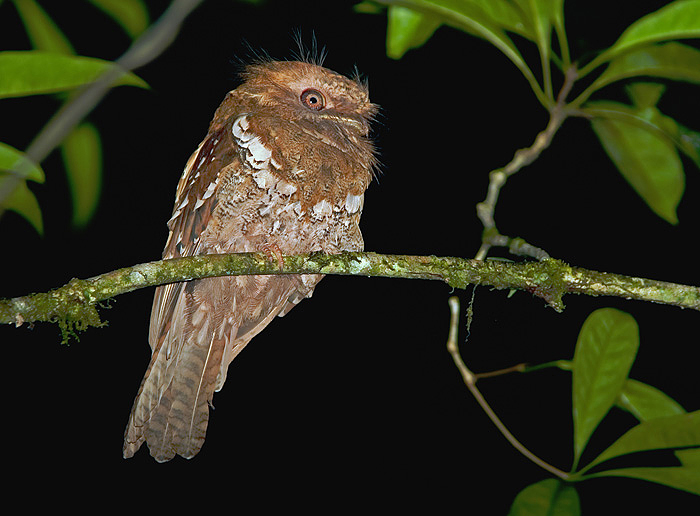
Visayan pre-tour:
28th January – 3rd February
2007
Leader: Rob Hutchinson
Participants: Daniel Benders,
Leif Gabrielsen, John Hiles, Stella Martin & Denis Walls
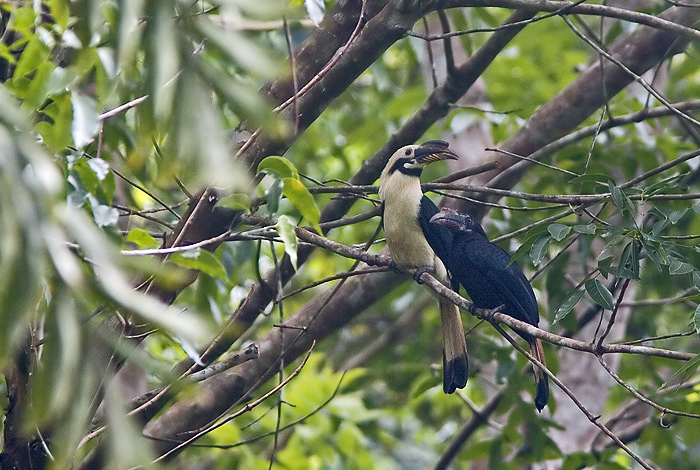
During the
week-long Visayan pre-tour extension we recorded 131 species including
45 Philippine endemics of which 11 were tour-exclusive endemics. Highlights
included the rare island-endemic Cebu Bulbul and Black Shama on Cebu,
Yellow-breasted Tailorbird and Azure-breasted Pitta on Bohol and a
host of rare endemics including Visayan Hornbill, Visayan Shama,
Visayan Flowerpecker and the stunning Flame-templed Babbler on Negros.
We began the tour
with a late afternoon flight from Manila to Cebu City where we enjoyed
our first San Miguel beers in the tropical surrounds of the hotel
garden before retiring to recoup some energy after long international
flights from various corners of the globe.
Early the next morning we departed Cebu City and headed inland.
Unfortunately the fine conditions on the coast deteriorated as we
headed into the central mountains and it was rather wet and windy when
we arrived at our destination of Tabunan, which is home to one of the
few remaining forest patches on the entire island. After a rather slow
and slippery walk up the trail into the forest our first highlight was
White-eared Brown-Dove while some of the group had brief views of our
first Black Shama, an island endemic, before arriving at the
‘viewpoint’ – in fact one of the few elevated pieces of limestone
allowing views into the forest canopy. The inclement conditions atop
the viewpoint were far from ideal and were undoubtedly a factor in our
lack of flowerpecker sightings but we did manage some excellent birds;
Philippine Serpent Eagle, Philippine Coucal, Philippine Pygmy
Woodpecker, Philippine Bulbul, Arctic Warbler, Pied Triller, Pied
Fantail, Grey-streaked Flycatcher, Everett’s White-eye and Red-keeled
Flowerpecker providing entertainment. Several endemic Magnificent
Sunbirds (a good split from Crimson Sunbird), vocal Cebu (Streak-breasted)
Bulbuls gave brief glimpses and our first Coleto with its bare head
appearing to exposing bulging pink brains! We also found the stunning
cebuensis Coppersmith Barbet with its brick-red face and
throat which made us ponder the possibilities of a future split. In
the mid-afternoon we descended again into the forest where everyone
now enjoyed views of the Black Shamas and we puzzled over the
cyornis blue-flycatchers which are currently lumped within
Mangrove Blue-Flycatcher but again seems a likely future split. Our
walk back to the village produced Grey-rumped Swiftlet, Striated
Grassbird, Paddyfield Pipit and Island Collared Dove in the
agricultural fields.
We were soon heading back to Cebu City, for a short ferry ride to
Bohol, our third Philippine island in 2 days. We arrived at our resort
in the evening, sadly too late to yet appreciate the surrounding
‘Chocolate Hills’ for which the area is famous.
A short drive the next morning brought us to the nearby Rajah Sikatuna
National Park where we were greeted almost immediately by an
entertaining group of ‘Samar’ Mindanao Hornbills. Although the birding
here is sometimes slow, the forest is fantastic and we spent a very
enjoyable morning along the forest trails. The first highlight was
actually not a bird, but a Philippine Colugo (often known as a ‘flying-lemur’)
a nocturnal flying squirrel that we were fortunate to see active
during the daytime. Next up was one of our main targets –
Yellow-breasted Tailorbird, endemic to Samar and Bohol this species is
quite easily located courtesy of its high pitched song but it is a
super-skulker and true to form not everyone managed good views of this
particular individual. The rest of the morning was enlivened by some
nice feeding flocks which included shy Mindanao Drongos,
Metallic-winged Sunbirds, Yellow-bellied Whistler, Blue Fantail,
Black-crowned Babblers and the near-endemic Rufous-tailed Jungle
Flycatcher which is shared with Borneo but very rarely recorded there.
We also chanced upon a smart group of Streaked Ground Babblers feeding
unobtrusively in the leaf litter and a more obliging Yellow-breasted
Tailorbird, although it soon melted away leaving some still frustrated.
Our afternoon again produced much the same in the mixed flocks but we
added a surprisingly elusive Black-faced Coucal and a flushed Red
Junglefowl. Staking out a clearing in the late afternoon produced a
Besra and a pair of Rufous-lored Kingfishers as they became active at
dusk. As darkness fell Great Eared-Nightjars hawked overhead and a
wintering Northern Boobook appeared followed a short while later by a
vocal pair of Philippine Boobooks and an impressive Atlas Moth
attracted by our powerful spot-light. A final stop along the road
produced calling Philippine Frogmouth and Everett’s Scops-Owl but
neither could be located and we had to be satisfied with another
Rufous-lored Kingfisher which we found roosting right above the road.
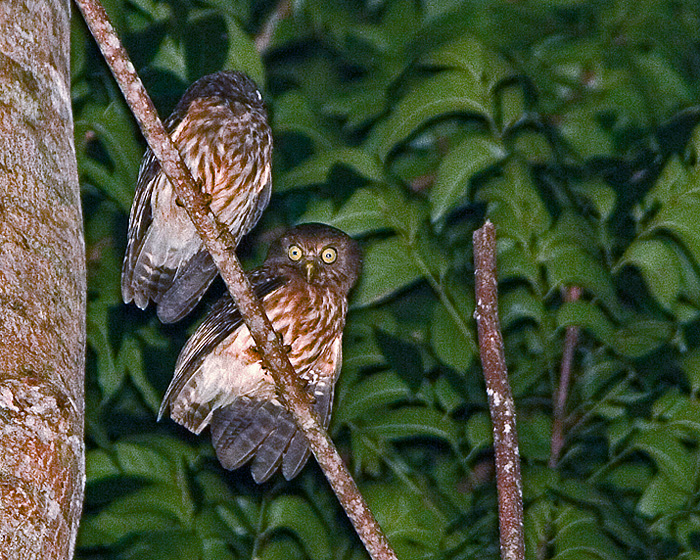
An early start
again the next morning began with flight views of a shy Besra then
some good activity around fruiting trees including White-eared Brown
Doves and a gorgeous Black-chinned Fruit Dove – a bird found on only a
few small islands outside the Philippines. Hitting the forest trails
again produced a group of Streaked Ground Babbler, this time singing
their hearts out in unison, Yellow-breasted Tailorbirds performed well
allowing everyone reasonable views and we finally saw a Rufous-fronted
Tailorbird after several frustrating encounters with elusive singing
individuals. Black-faced Coucal was again seen as were our first
Greater Flameback, an impressive White-bellied Woodpecker and a
fruiting tree attracted Samar Hornbills, Bar-bellied Cuckoo-shrike,
Yellow-wattled Bulbul, Philippine Oriole and Philippine Fairy Bluebird.
In the late afternoon the distant calls of an Steere’s (Azure-breasted)
Pitta were picked out but soon went quiet. Making our way towards
where the birds had been calling a small amount of coaxing with the
tape brought an immediate response as the bird flew up onto an open
branch right in front of us with the amazing azure-blue underparts
lighting up the undergrowth in the gathering gloom before his
attention was grabbed by his mate nearby and both birds disappeared in
tandem across the road. Waiting at a large clearing at dusk produced
great views of a Philippine Colugo ‘flying’ between large trees and
several Great-eared Nightjars but not the hoped for Philippine
Nightjars which appear to have suffered from habitat loss here.
The next morning we
returned again to the harbour at Tagbilaran but this time took the
fast craft ferry to the town to Dumaguete on the south-east coast of
Negros where Great Crested, Common and Whiskered Terns were noted
feeding offshore from our hotel. After lunch we first headed north
along the coast where an area of salt pans provided an interesting
diversion from the forest birding. The pools were teaming with
shorebirds; Asian Golden Plovers, Black-winged Stilts, Wood Sandpiper
and Kentish Plover were the prominent species but we also found Little
Ringed Plover, Greater Sandplover, Greenshank and Marsh Sandpiper. Two
Javan Pond Heron were found and a single Yellow Bittern was seen in
flight, while the reedy margins hosted at least 5 White-browed Crake
and introduced Java Sparrows were a surprise find feeding with
Eurasian Tree Sparrows nearby. From here we continued up into the
mountains arriving mid-afternoon at a wet and windy Balinsasayao
Lakes. Despite the weather we ventured out and recorded several new
species including Lemon-throated Leaf-Warbler and Visayan Blue-headed
Fantail along with Grey-streaked Flycatcher, Elegant Tits,
Orange-bellied Flowerpecker and calling Philippine Tailorbird. A
feeding flock containing Bar-bellied Cuckoo-shrike, Visayan
Balicassiao and White-winged Cuckoo-shrike passed through quickly but
a pair of Flaming Sunbirds feeding at very close range were much more
obliging and deserved the bird of the day vote they received.
Unfortunately the
poor weather was still present the following morning, washing away our
plans to visit Mount Talinis so we opted again to visit the
Balinsasayao Twin Lakes. The weather was improved since the previous
day and we were rewarded with great views of the increasingly rare
Visayan Hornbill of which we saw 2 groups totalling at least 5
individuals. The flowering trees again attracted the Flaming Sunbirds
plus Yellowish White-eyes. Exploration of the newly created trail
system around the lake gave some nice feeding flocks including the
fantail, tits and leaf-warblers from the previous day plus
White-vented Whistler, Coleto, Visayan Balicassiao, Bar-bellied and
White-winged Cuckoo-shrikes and our first Yellow-breasted Fruit Doves
of the tour.
After another excellent lunch the afternoon was spent on the drive to
Bacolod in the north-west of the island with Common Moorhen the only
bird of particular note during the journey.
The next morning we departed early, arriving just prior to dawn at
Mambucal on the lower slopes of Mount Kanlaon, an active volcano in
the north of the island. The initial walk up through open fields and
scrub then pine plantations produced little of interest except calling
Spotted Wood Kingfishers and the ubiquitous Philippine Bulbuls but as
soon as we reached the lower edge of the native forest, things
immediately heated up. Our first large feeding flock provided great
excitement with the expected Elegant Tits, Visayan Blue-headed Fantail,
Stripe-headed Rhabdornis, Coleto and Yellowish White-eyes accompanied
by several striking, white-bellied, Visayan Balicassiao and the
increasingly rare White-winged Cuckoo-shrike.
The hoped for Visayan Shama remained strangely silent in their usual
haunts but some reasonable views of White-vented Whistlers were had
and continuing along the trail, a medium-sized brown heron was flushed
from the forest floor and flew into a nearby tree allowing those well
positioned a good view before flying again and its identity confirmed
as a Japanese Night Heron - a rare winter visitor to the Philippines
and a species listed as endangered by Birdlife due primarily to
deforestation in its breeding and wintering areas.
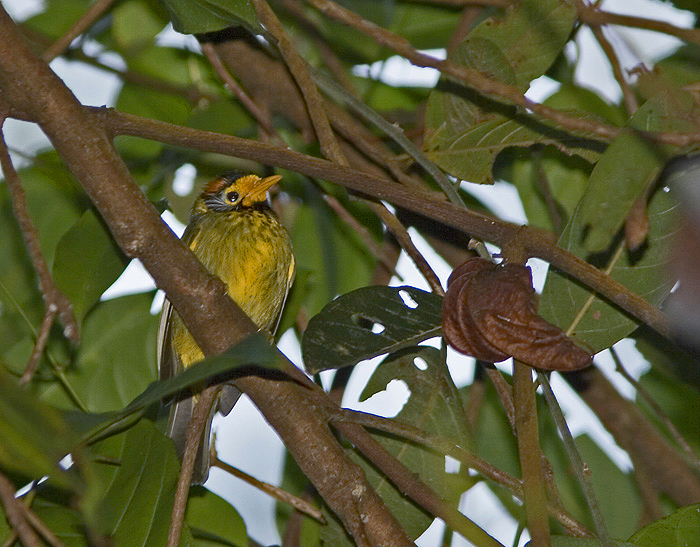
Reaching primary forest it was not long before a melodious song drew
our attention to our big target – the endemic Flame-templed Babbler,
which proceeded to perform impeccably as a pair of these stunning
birds sat motionless in the overhead trees allowing everyone prolonged
and satisfying views. More views of Flame-templed Babblers enhanced
feeding flocks during the rest of the morning as did Lemon-throated
Leaf-Warblers, Philippine Tailorbirds and our first Bicoloured
Flowerpecker.
Both White-browed Shortwing and a beautiful Red-bellied Pitta glowing
in the understory were seen in exactly the same spots walking up and
down the trail and both seemed likely to be nesting in the respective
areas. The same might have accounted for the silence and lack of
response from the Visayan Shamas and we were extremely lucky when one
of these skulking birds, giving only short snatches of song, was
spotted sitting quietly and motionless in the undergrowth, the lack of
rufous rump and white wing-bars as compared to the White-browed Shama
of Luzon, combined with the distinct vocalisations all confirming this
is a good ‘split’ from that species.
Our next highlight was a male Spotted Wood Kingfisher sitting quietly
in the lower story of the forest and giving great views with its
buff-spangled green upperparts, rufous moustache, collar and throat
contrasting with a black ‘bandit mask’ and cobalt sub-moustachial
patch, combining to make this arguably the most beautiful bird of the
day.
We finished the afternoon in relaxed fashion around the popular
tourist spot of Mambucal where an impressive colony of Grey-rumped
Swiftlets were nesting underneath a river bridge and a group of Purple
Needletails performing regular fly-bys allowed us all to appreciate
these amazingly powerful flying machines and provided a challenge to
the photographers in the group! The Visayan Flowerpeckers proved more
elusive than usual but after much searching everyone enjoyed great
views of this endemic with the black-breast and broad red stripe on
the underparts clearly on show; features which separate it from the
widespread Red-keeled Flowerpecker found elsewhere on the Philippines
and with which it was formerly lumped.
Main tour:
4th – 24th February 2007
Leader: Rob Hutchinson
Participants: Daniel Benders, Leif Gabrielsen, John Hiles, Max
Jensen,
Stella Martin & Denis Walls

Our main three-week
Philippines tour was extremely successful with a grand total of 145
endemics among the 323 species recorded. Highlights included the rare
and critically endangered Philippine Eagle, 2 representatives of the
endemic Rhabdornis family, 3 pitta species (Hooded,
Red-bellied and the stunning endemic Azure-breasted), 6 endemic
kingfishers including the impressive Blue-capped and Spotted
Wood-Kingfishers and the rarely-seen Philippine Dwarf-Kingfisher. We
also enjoyed great views of Short-crested and Celestial Monarch,
Philippine Cockatoo and an amazing close encounter with a stunning
male Palawan Peacock-Pheasant.
The main tour began
in Luzon where after morning arrivals into Manila we transferred to
Los Banos on the lower slopes of Mount Makiling, seeing
Black-shouldered Kite en route and Brahminy Kite, Osprey, Common and
Whiskered Terns on Laguna de Bay from our hotel. We began in the
afternoon with a visit to the nearby University of the Philippines
where a river running through the campus produced excellent views of
the hoped-for Indigo-banded Kingfisher, with both male and female
birds performing. The surrounding trees produced Philippine Pygmy
Woodpecker and good numbers of Lowland White-eyes were seen.
In the late afternoon a patient wait at a nearby grassland area
produced good views of Spotted Buttonquails coming out to feed on a
track while Plain Bush-hens called unseen nearby. The grasslands also
hosted numerous Striated Grassbirds, Bright-capped and Zitting
Cisticolas, Black-and-White Triller in nearby trees and a smart Blue
Rock Thrush.
The following
morning we began at the forest edge making our way into the wonderful
forest that remains on Mount Makiling. Our progress along the track
was slow however with new birds appearing frequently. Early excitement
was provided by a group of Luzon Hornbills visiting a fruiting tree.
Next came scope views of Black-chinned Fruit-Dove, punk-headed
Red-crested Malkohas, perched Guaibero – a cute endemic parrot, and a
particularly worthwhile stop which produced our first male Philippine
Trogon and the bizarre but spectacular Scale-feathered Malkoha. We
also saw some of the skulkers including White-browed Shama and
Grey-backed Tailorbird but a calling Luzon Bleeding-heart couldn’t be
persuaded to appear.
During the morning our haul of species along the forest track included;
White-eared Brown-Dove, Colasisi, Violet Cuckoo (including a striking
violet male with luminous red bill), several Black-and-White Trillers,
Philippine Pygmy Woodpecker, Yellow-vented Bulbul, Luzon Balicassiao,
Stripe-headed Rhabdornis, Luzon Blue-headed Fantail, wintering Ashy
Minivets, Lowland and Yellowish White-eyes, Buzzing and Striped
Flowerpeckers, Lemon-throated Leaf-Warbler, Purple-throated, Flaming
and Handsome Sunbirds.
Returning to the forest edge a large bare tree was host to Coleto,
Coppersmith Barbet and three petite Philippine Falconets making
frequent hunting sorties for draogonflies.
In the afternoon we enjoyed many of these birds again and a wander in
the nearby botanical gardens added Rusty-breasted Cuckoo and
Philippine Drongo Cuckoo. As dusk approached Spotted Wood Kingfishers
became vocal and a pair showed well at the forest edge as Philippine
Boobooks called at nightfall but were strangely quiet thereafter and
we didn’t managed to see any tonight.
The next morning we
drove higher up the mountain. The lush forest here had been battered
somewhat by recent typhoons but was still productive; we had our first
good views of Grey-backed Tailorbirds after hearing and glimpsing
several, a smart male White-browed Shama sang from an open perch and
we bumped into another stunning Spotted Wood Kingfisher in the forest.
The often elusive Luzon Blue-headed Fantail was seen again as were
several Red-crested Malkoha and our first Philippine Coucal.
A calling Luzon Bleeding-heart couldn’t be attracted so we scrambled
up a nearby slope to get closer but managed only brief flight views of
this shy ground-dweller.
Making our way back down through the forest one of the calling
Philippine Hawk Cuckoos was attracted in and a stunning male Flaming
Sunbird again fed on their favoured red flowers low by the roadside.
In exactly the same place as the previous day, a Luzon Bleeding-heart
was again calling from its favoured steep sided gully but on this
occasion it surprised us all by responding to playback by wandering
out into the valley bottom, although sadly it was typically shy and
flew back into cover as soon as it noticed our presence.
At the forest edge, Philippine Falconets were again utilising their
favourite lookout and 2 Ospreys were again over the lake next to the
hotel as we took a break from the midday heat.
Our afternoon explorations of the lower parts of the forest were again
productive with Red-crested Malkoha particularly in evidence along
with two shyer Scale-feathered Malkoha, a single Philippine Drongo
Cuckoo, Bicoloured and Pygmy Flowerpeckers and a spectacular group of
at least 15 Luzon Hornbills. Waiting until dusk we were very well
rewarded as the silhouette of a Philippine Scops Owl floated by in
response to our tape and was soon relocated for excellent views of
this large scops owl brilliantly lit in our spot-light.

The following
morning we transferred back to Manila and took a flight to the
distinctly tropical island of Palawan. First stop was the seafront at
Garceliano beach on the outskirts of the capital Puerto Princessa
where we arrived just in the knick of time as the rising tide hadn’t
yet pushed off the feeding waders. A variety of egrets included close
views of Chinese Egret and we had a nice comparison with nearby
Pacific Reef Egrets. A good assortment of shorebirds here included
Grey and Asian Golden Plovers, Kentish Plover, Greater and Lesser
Sandplovers, Whimbrel, Ruddy Turnstone, Common Redshank, Red-necked
Stint and Grey-tailed Tattlers. Immense orange and blue Stork-billed
Kingfishers posed in the mangroves as several Palawan Swiftlets were
noted feeding overhead - our first island endemic.
After a delicious lunch we began the drive towards Sabang albeit with
several birding stops. The first break in an area of mangroves,
produced several Purple-throated and Copper-throated Sunbirds and
Dollarbirds nearby. The next stop was next to a forested valley and
walking along the roadsides gave some great birding. Our first of many
of the island endemics appeared with Blue Paradise Flycatcher,
White-vented Shama, Sulphur-bellied Bulbul, Shelley’s Sunbird, Palawan
Flowerpecker, Pygmy Flowerpecker (here of the distinct palawanorum
subspecies), Yellow-throated Leafbird and fine perched views of the
near-endemic Blue-naped Parrot which have disappeared from most of the
archipelago but are still quite common here. We also saw several
species found only on Palawan within the Philippines such as
Chestnut-breasted Malkoha, Dark-throated Oriole, Common Iora,
Grey-cheeked Bulbul, Ashy Drongo and Rufous-tailed Tailorbird and
Brown-backed Needletails overhead. Walking further down the road we
added Bar-bellied Cuckoo-shrike, Asian Drongo Cuckoo, Oriental Honey
Buzzard, yet more Blue-naped Parrots, Eastern Hill Myna, Asian Fairy
Bluebird and two distinctive birds which although ‘officially’
regarded as subspecies are widely regarded as full species in their
own right; Palawan Drongo and Palawan Crow, both of which show plumage,
voice and habitat preference far removed from their nearest relatives.
One of everyone’s most want birds on Palawan is the truly spectacular
Palawan Peacock Pheasant, this bird has become much easier in recent
years thanks to a rather ‘tame’ bird inside the park but genuine
‘wild’ birds have remained an elusive target for visiting birders.
Consequently as we settled down by the roadside to look for a calling
bird in the valley below expectation were not high, but amazingly the
bird surprised us all by wandering out into the open among the bamboo
below us allowing good views before disappearing again into the valley!
We followed this with amazing views of a group of 4 Great Slaty
Woodpeckers as these huge birds noisily danced around one another in
the tree tops with wings spread, although we were hard pushed to
decide whether it was an act of aggression or affection!
We ended the day with a spot of night-birding and with the calling
Hooded Pittas giving way to a distant Spotted Wood Owl, Large-tailed
Nightjars were the first to come out to play, hawking close overhead.
As darkness fell the weird and wonderful screams and whistles of
Palawan Frogmouths began to emanate from the surrounding forests and
it wasn’t long before we were admiring one of these bizarre hairy
creatures in the spotlight. Heading a little deeper into the forest a
patient wait was rewarded by an equally bizarre ‘crackling’ which
announced the presence of a Palawan Scops Owl nearby and again we were
soon admiring this large scops-owl peering back at us from close range
with piercing orange eyes. After a highly successful session, with
both Palawan endemic nightbirds seen extremely well, we headed for our
lodge at Sabang, our home for the next 2 nights.
At dawn the next morning we took a boat from Sabang along the
coastline of Saint Paul National Park with a spectacular view of the
huge limestone cliffs and forest as far as the eye could see. Our
first stop was at the ‘underground river’ for which the park is justly
famous as this is one of the longest subterranean rivers in the world.
The area around the ranger station here gives great birding and in
addition to more great views of many of the endemics seen the previous
day, we also added a cute party of Ashy-headed Babblers bouncing
around in the undergrowth, Tabon Scrubfowl, Olive-winged Bulbul and
Bold-striped Tit Babblers. It wasn’t too long before the star of the
show appeared and we all enjoyed point blank views of the stunning
male Palawan Peacock Pheasant in all his glory; striking white face
markings, emerald hued crest, gold spangled rump and tail with blue
‘eyes’ and silky black underparts contrasting with vivid iridescent
blue mantle and wing feathers all combining in one of the rarest and
most spectacular pheasants in the world. This particular individual is
much habituated to humans but took a particular liking to Leif who
could be seen running along the trail with this feisty bird in hot
pursuit!

Talking the boat
again we headed back along the coast to another ranger station in
search of another of the star birds, the forest dwelling Falcated
Ground Babbler. As soon as we reached a suitable area the birds could
be heard duetting but try as we might we couldn’t tempt them closer so
we took plan B and headed into the forest. The birds continued singing
but it was a long and patient search before we finally located them,
to their credit they did then oblige, with a pair singing from atop a
fallen log and they were definitely worth the effort and long wait!
Other birds in this area were a nice male Shelley’s Sunbird singing
from high in the canopy and a diminutive Rufous-backed Kigfisher which
sat quietly in the understory. Walking back along the coast a
beautiful deserted beach played host to a pair of the rapidly
declining Malaysian Plover and we enjoyed nice scope views in this
wonderful setting.
After lunch back at our resort we again spent the afternoon birding
back along the road in the direction of Puerto Princessa. Here we
enjoyed many of the previous day’s birds including Blue Paradise
Flycatcher, several White-vented Shama, Asian Drongo Cuckoo,
Black-throated Oriole, Asian Fairy Bluebirds, Eastern Hill Mynas and
an immature Changeable Hawk Eagle. We also found a nice female Palawan
Blue Flycatcher, a Striped Flowerpecker accompanying the commoner
Palawan and Pygmy, then finally after much searching, a smart yellow,
black and white Palawan Tit feeding right above our heads. A viewpoint
overlooking a forested limestone crag gave nice views of several
Thick-billed Green-Pigeons while the screeching calls of Blue-headed
Racquet-tails drew our attention and we had several views as the flew
around the limestone rock before circling directly overhead with
racquets clearly on show. We finished the day with several
Large-tailed Nightjars feeding at dusk over the paddies adjacent to
the resort.
After our great
success the previous day some opted for another morning visit to the
‘underground river’ but this time with an amazing boat trip into this
underground wilderness, home to thousands of bats and swiftlets. The
rest of us meanwhile headed for the forest. Palawan Hornbill was still
noticeably absent but among the now expected species we also saw yet
another ‘wild’ male Palawan Peacock Pheasant, a Tabon Scrubfowl and
particularly nice views of Blue Paradise Flycatchers. The area around
our hotel also had Thick-billed Green-Pigeon, White-breasted Waterhen
and Pintail Snipe. In the afternoon we headed back again to Puerto
Princessa with several birding stops including a Crested Serpent Eagle
and Grey-faced Buzzard circling together, Palawan Tits which were
still performing in the same spot as the previous day and a small
group of Fiery Minivets - a new addition.
The next morning we headed south from Puerto Princessa to bird the
Balsahan Trail within the Iwahig Penal Colony. The forest here is more
secondary than at Saint Paul and this is the favoured habitat for our
key target bird - the endemic Melodious Babbler. It wasn’t long before
we heard the sweet, mournful song of the babblers and we all soon
enjoyed views of the birds as they fed and sang in their favoured vine
tangles. Continuing on along the trail we finally, after much effort,
saw our first Palawan Hornbill, when a considerate bird performed a
nice fly-past allowing the whole group to connect. Continuing along
the trail a Pechora Pipit was flushed from the trail and perched
briefly but vanished again into the undergrowth before everyone could
enjoy views. As we enjoyed a charming pair of Ashy-headed Babblers
feeding close to the trail we heard the calls of the islands other
endemic babbler which had given us such a run around at Saint Paul.
This individual was much more obliging and we got great views of the
Falcated Ground Babbler singing strongly right by the side of the
trail. Further exploration produced excellent views of two Hooded
Pittas, equally stunning Rufous-backed Kingfishers, Common Flameback,
Fiery Minivets, two more obliging Melodious Babblers, Velvet-fronted
Nuthatch, Bold-striped Tit Babbler, Asian Fairy Bluebird, a perched
Crested Goshawk and some of the now familiar Palawan endemics such as
Yellow-throated Leafbird, Sulphur-bellied Bulbul and Blue Paradise
Flycatchers.

Leaving the forest we spent some time birding the paddyfields and fish
ponds along the entrance road to the penal colony. Shorebirds were
abundant with Black-winged Stilts, Redshank, Greenshank, Little Ringed
Plover, Kentish Plover, Lesser and Greater Sandplover, Asiatic Golden
Plover, Red-necked Stint and Long-toed Stint all present. Swinhoes
Snipe provided an identification challenge but obliged with nice scope
views and good views in flight when they also gave their distinctive
calls. A single Moorhen and two White-browed Crakes were found
creeping along the reedy edge of a well vegetated pond.
Soon it was time to head south, stopping at a roadside marsh for
Purple Heron and Yellow Bittern before continuing to our overnight
stop at a beach resort in the small coastal town of Narra. Just
offshore from Narra lies Rasa Island where dedicated conservation work
has secured the islands as one of the last remaining strongholds for
the endangered Philippine Cockatoo. In the afternoon we boarded boats
and headed out to the island, stopping initially at a watchtower on
the south side of the island where some were fortunate to see a
handful of cockatoos perched in distant trees. The mangroves near the
quay also produced several Copper-throated Sunbirds and a flyover
Osprey. Since the weather was fine we set off again in the boats and
headed around the north side of the island to the cockatoo roost area
and spent some time watching the birds coming into their favoured
sleeping trees, finishing the day with a grand total of more than 50
birds. As dark approached we landed again on the island, close to a
small settlement, where the secondary scrub and coconut trees provide
ideal habitat for the Mantanani Scops Owl – a small island specialist
which is restricted to small islands in the Philippines archipelago
and a few islands off the north coast of Borneo. Unfortunately they
were not very cooperative tonight and we left with just a few calling
birds to show for our efforts.
The next morning we departed early arriving at a strategic area of
roadside forest just after dawn. Here we were greeted by a smart group
of four Palawan Hornbills perched high in the treetops and a short
stroll along the roadside found Yellow-throated Leafbird. It was not
long before we heard the song of our main target coming from a bamboo
filled gully so we made our way carefully into position nearby and we
fortunate to soon locate the singing bird – an elusive Palawan
Flycatcher which nevertheless gave some nice views, and complete a
clean-sweep of possible Palawan endemics. Given our early success we
decided to spend some time in the paddyfields closer to Puerto
Princessa town finding three Pink-necked Green Pigeons, several
White-breasted Waterhen and Moorhen, and single White-browed and
Slaty-breasted Crakes.
Our mid-morning
flight back to Manila was delayed giving us a tight connection for our
flight to Cagayan de Oro but we made it with no problems, even finding
time a quick take-away lunch at Manila airport. From Cagayan de Oro
airport we were whisked south into Bukidnon province, stopping off in
Damitan village where our luggage was loaded onto a convoy of horses
for the trek into the Kitanglad Mountains.
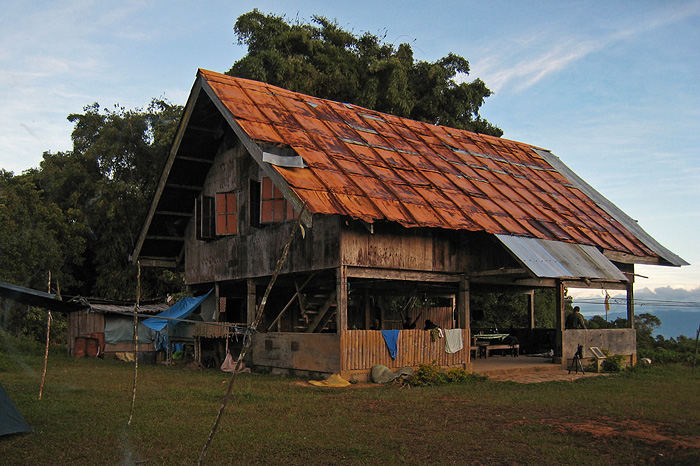
The walk up to camp produced Black-shouldered Kite, smart black-headed
nasutus Long-tailed Shrikes, Striated and Tawny Grassbirds,
and on the higher slopes, large groups of wintering Eye-browed
Thrushes. As we arrived at dusk a Bukidnon Woodcock was heard in
roding flight overhead but we didn’t manage views.
After dinner we ventured into the nearby forest and with patience and
some gentle coaxing we were soon enjoying a bizarre Philippine
Frogmouth perfectly framed in the spotlight. Mindanao Scops Owl, Giant
Scops Owl and Philippine Nightjar were all heard.
The following
morning a roding Bukidnon Woodcock heralded a fine dawn so after an
early breakfast we set off up the mountain eager to take advantage of
the good weather conditions. Our first new birds were endemic
Stripe-breasted Rhabdornis perched conspicuously atop dead snags and
shortly after we found an excellent flowering tree attracting a host
of birds and we quickly saw our first Olive-capped Flowerpeckers and
Grey-hooded Sunbirds amoung the feeding birds with a smart
Black-and-Cinnamon Fantail nearby. More open grassy areas produced
Paddyfield Pipit, several noisy Tawny Grassbirds, single Striated
Grassbird, a fly-by Philippine Cuckoo Dove and several Short-tailed
Glossy Starlings.
A short stop in a known Blue-capped Wood Kingfisher territory drew an
immediate vocal response and after a little time the male bird flew in
to investigate us, perching at close range for just a few seconds
before disappearing back into the forested valley.
As we reached a nice lookout at least four Apo Mynas were found
feeding on fruiting trees and we were able to study these unique mynas
at leisure, looking rather bizaare with their long-tails, large yellow
eye-skin and punk-style hair cuts.
As we reached the higher parts of the mountain, we entered some nice
forest patches, finding a small group of Yellow-breasted Fruit Doves,
shy Island Thrushes and a Great-eared Nightjar which flushed from
almost under our feet and circled us before dropping back into the
forest again. Amethyst Brown Dove and Mindanao Montane Racquet-tail
were both only heard but after some time one of the remaining high
altitude specialties appeared – an Apo Sunbird which perched just
above our heads.
Throughout the day mixed flocks provided some exciting birding with a
fantastic variety of species; Mountain White-eye was by far the most
abundant species with Elegant Tit, Sulphur-billed Nuthatch and
Yellow-bellied Whistler were all regular and we found smaller numbers
of Little Pied Flycatchers, Mountain Leaf Warblers and a single
wintering Mugimaki Flycatcher. New endemics in some of the flocks
including Rufous-headed Tailorbird, Brown Tit-Babbler, groups of
Cinnamon Ibon, Black-masked White-eyes, McGregor’s Cuckooshrike, a
single White-cheeked Bullfinch and a major surprise in the form of a
Whiskered Flowerpecker – a rare endemic which is normally found only
in the mountains further south on Mindanao.
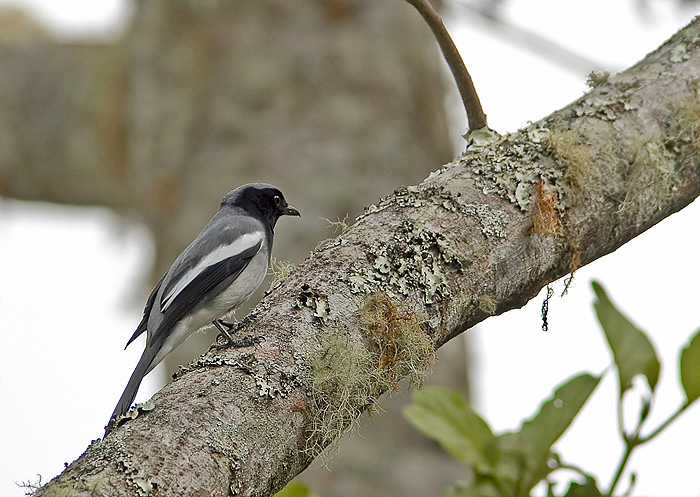
Having located all
the expected montane endemics we dropped down a short way in order to
enjoy our picnic lunch at one of the viewpoints providing panoramic
views of the surrounding forest slopes. This proved a great move as we
quickly located two more White-cheeked Bullfinches in the nearby trees
and moments later our local guide Danny called out that he had a large
raptor flying overhead and we all looked up to by stunned by the
amazing sight of an adult Philippine Eagle passing right overhead
before droping down into a distant isolate valley. The bird was
clutching a Philippine Colugo – one of their main prey items – in its
talons which it was presumable taking to a hidden nest in that far off
valley.
The remainder of the day was spent scanning from the viewpoints in the
hope that the Philippine Eagle might reappear. It didn’t, but other
raptors included the distinctive philippensis Oriental
Honey-Buzzard (a likely future split), Philippine Serpent Eagle and a
Changeable Hawk Eagle.
Walking back in the late afternoon, high pitched calls drew our
attention to a Red-eared Parrotfinch skulking in a thicket. This bird
was typically difficult to see but after 30 minutes scrambling around
on our knees and imitating the calls we all managed at least some sort
of views of the bird. Further down we finished with nice looks at two
Mindanao Hornbills which were calling from the highest trees on the
nearby valley sides.
At dusk we waited in a large clearing near the lodge and in the fading
light had great views of both Great-eared and Philippine Nightjars.
Unfortunately the hoped-for Bukidnon Woodcock didn’t appear this
evening but some good compensation came from a ghostly-white Eastern
Grass Owl which floated over the clearing as we waited.
Since some of the
group had missed the eagle the previous day, much of our time today
was spent at the viewpoints on the mountain. The walk up to the
viewpoint gave two Mountain Shrikes for some, a single Stripe-breasted
Rhabdornis and two Mindanao Hornbills. In the small forest patches en
route we found a White-browed Shortwing, Rufous-headed Tailorbirds, a
skulking Long-tailed Ground Warbler, Snowy-browed Flycatcher,
McGregor’s Cuckooshrike and a Rusty-breasted Cuckoo.
Our watching didn’t produce the hoped for eagle but we did find two
Oriental Honey-Buzzards, Philippine Serpent Eagle, Changeable Hawk
Eagle and Peregrine.
Although raptors were the main focus we also added our first fly-over
Mindanao Montane Racquet-tail have only heard then the previous day,
many Philippine Swiftlets, a single Plain Martin and awesome views of
Purple Needletails which ‘buzzed’ us at high speed and very close
range on several occasions. Fruiting trees near the viewpoint
attracted Philippines Cuckoo Dove, some very smart Yellow-breasted
Fruit Doves and a Mugimaki Flycatcher. We also saw two White-cheeked
Bullfinch and a few Apo Mynas which appeared nearby, and on the walk
back down to the lodge a ‘green-bullet’ fly-by Red-eared Parrotfinch.
At dusk the lodge clearing gave views of Philippine Nightjar while
those who returned to the clearing above the lodge were lucky enough
to see two Bukidnon Woodcock leaving their daytime roost. After dinner
we set off again into the forest, this time in pursuit of a calling
Mindanao Scops Owl. The owl seemed distant from the lodge but as we
picked our way along the trail we gradually got closer and closer
until we tracked the bird to a large clump of dense bamboo. Settling
into place we called back to the bird which almost immediately went
quiet. We waited patiently and before long the bird called again, this
time clearly closer and within moments it was sitting in our
spot-light, perched brilliantly in the open on a thin bamboo stem.
There it stayed calling contentedly as we enjoyed this tiny but
beautifully patterned owl before it flew again to resume calling from
a different perch. This owl is typically found at much higher
altitudes on this mountain and is notoriously difficult to see so we
were extremely fortunate to see one so well and so close to our lodge.
The next day
further raptor watching produced two Oriental Honey Buzzards,
Philippine Serpent Eagle, Peregrine and an Oriental Hobby.
The condition were more overcast today and this was clearly favoured
by the Mindanao Montane Racquet-tails with more than 15 logged by the
end of the day including one bird perched nicely in the scope.
Other birds seen in the vicinity of the viewpoint were Yellow-breasted
Fruit Dove, Philippine Cuckoo Dove, Mindanao Hornbill, at least five
Stripe-breasted Rhabdornis, Rufous-headed Tailorbird, Long-tailed
Ground Warbler, Apo Myna and the overwintering Mugimaki Flycatcher.
Top prize however undoubtedly went to no less than three Bukidnon
Woodcocks which were flushed together from a tiny path-side pond, one
of which landed on the trail to give excellent views.
Those who opted for a more leisurely day close to the lodge also added
Whiskered Treeswift, Buzzing Flowerpecker, Philippine Leaf Warbler,
McGregor’s Cuckooshrike, montanus Greater Flameback and
Philippine Fairy Bluebird.
In the gathering gloom a calling Philippine Hawk Cuckoo was seen
nicely right next to the lodge and after dinner the Mindanao Scops Owl
was again seen, this time in Bamboo right next to the lodge!
We departed our camp after breakfast the next morning, retracing our
steps to Damitan village before making the long drive around the
north-east coast of Mindanao, arriving in the town of Bislig in the
late afternoon where we checked into the ‘Paper Country Inn’, our home
for the next four nights.
We set off well
before dawn the next way, utilising a Filipino ‘jeepney’, the only
transport suitable for navigating the rough and bumpy logging tracks
within the concession. Our aim this morning was to travel far into the
heart of the concession to a good area of forest which has thus far
remained more or less untouched. The morning began on an amazing high
when a Celestial Monarch was heard giving its distinctive three-note
whistle from far down the slope below us. The bird continued to call
strongly but it was some time before it finally came up to investigate
us. When it did appear the effort was well worthwhile – the bird, a
gorgeous male, perched right over our heads, a cobalt blue flycatcher
with lime green eye-ring, blue bill, and a long powder-blue crest
draped over the nape – quite simply one of the most stunning endemics
on the islands and we were fortunate enough to see it within hours of
our time here!
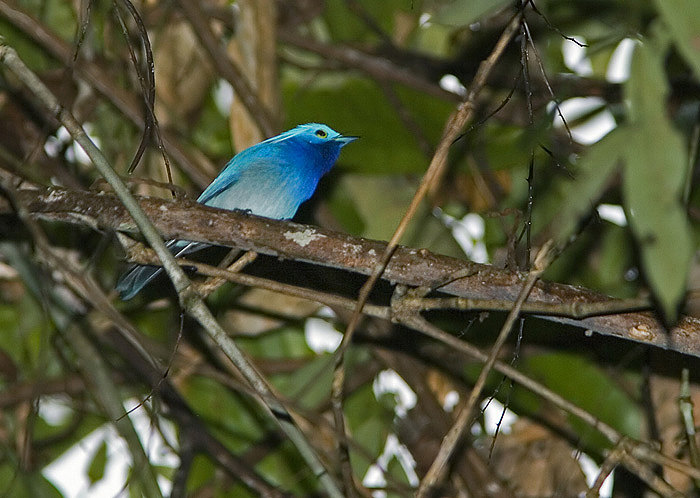
As we made our way further along the track a sharp high pitched
whistle demanded attention and we were soon watching an amazing
Philippine Dwarf Kingfisher perched just in front of us – this is one
of the most difficult of all Philippine endemics to see and this one
amazed even the leader by giving such amazing views.
It wasn’t long before we started to encounter some nice mixed feeding
flocks which soon produced a great variety of species; Blue Fantail
and Philippine Oriole were familiar from our time on Bohol but the
Black-crowned Babblers of Bohol were replaced here by Rusty-crowned
Babblers and they were joined by smaller numbers of Mindanao Pygmy
Babblers, an island endemic following a recent split from the ‘Pygmy
Babbler’. Yellowish Bulbuls, Philippine Leafbirds, Rufous-fronted
Tailorbird, Philippine Leaf Warbler also joined the flocks
occasionally but the highlights were amazing orange-hued Mindanao
Paradise Flycatchers, yet another Celestial Monarch (this time ‘only’
a female) and on two occasions Short-crested Monarchs appeared,
completing the duo of endemic monarchs which are always a major target
for visiting birders.
One of the canopy flocks produced distant views of the rather scarce
Black-bibbed Cuckooshrike and a small party of Scarlet Minivets, here
of the race gonzalesi which with their distinctive calls and
plumage seem certain to be split from other Philippine and mainland
Asia races once the complexities of the group are unravelled.
Flowering trees along the track attracted Metallic-winged and Handsome
Sunbirds, Orange-bellied and Pygmy Flowerpeckers and several
Naked-faced Spiderhunters.
Approaching a high point in the track, the load booming calls of
Pink-bellied Imperial Pigeons which had accompanied us for almost the
entire walk became much louder and careful scanning soon picked out
two birds perched in the treetops at eye-level where we could enjoy
excellent scope views of this impressive bird which has sadly become
very scare is recent years due to hunting pressures.
We walked on eager to reach a gully where we had often seen a pair of
Blue-capped Wood Kingfishers in previous years. It was already hot by
the time we arrived but the birds soon began calling from deep in the
shady valley below. Unfortunately, however hard we tried we couldn’t
tempt them any closer so the only option was to scramble down into the
gully below. This paid dividend as the birds were quickly located,
with three birds, 2 adults and an immature, giving nice close views
and performing well for the photographers amoungst us.
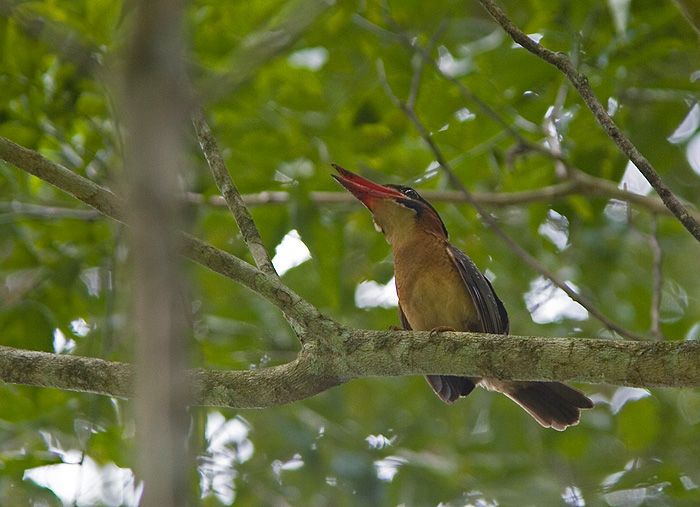
As we made our way back to the jeepney a Black-chinned Fruit Dove was
flushed but quickly relocated for excellent views and we finished the
morning with fantastic views of Rufous Hornbill; a family party of
three birds appeared and gave both perched and flight views of this,
arguably the most beautiful of the endemic hornbills in the
Philippines.
After lunch we made our way to a different area stopping for no less
than four Philippine Falconets perched on road-side tress and a smart
Black-faced Coucal. In the afternoon we visited a different road where
although the forest was very quiet we managed to tape in a male Little
Slaty Flycatcher but it only gave brief views. Some time was spent in
a nearby forest clearing which was very productive; a perched Besra
allowed a close approach, Blue-crowned Racquet-tail gave nice views
and hornbills included at least four Mindanao Hornbills and a nice
flock of three Writhed Hornbills which completed our possible PICOP
hornbill set as early as day one. We also saw a few Philippine Green
Pigeons, yet more Philippine Falconets, and our first Philippine
Needletails which instantly became a favourite as the patrolled at
high speed on the most incredible ‘butter-knife’ shaped wings.
Making our way back
towards Bislig we stopped first at a small road-side pool which has
for many years been home to a pair of Silvery Kingfishers. As usual
the birds didn’t disappoint and their high pitched calls soon drew
attention to this smart bird perched on dead branches at the edges of
the pond. We spent some time studying this lovely bird with its
blue-black plumage highlighted with silvery spangles on the head and
wing coverts, all contrasting with bright white throat, belly and
stripe along the back. All of this topped with amazing bright-red feet
– an amazing bird which the field guide illustration doesn’t even
begin to do justice.
Be began the next morning in an area of secondary forest where
Everett’s White-eyes, Purple-throated and Metallic-winged Sunbirds,
and Brown Tit Babbler were all common. It wasn’t too long before the
whistled song of our target species was heard from a nearby forest
patch. We made our way careful into the forest and soon enjoyed some
good looks as a smart male Little Slaty Flycatcher as it continually
circled us in the surrounding understory. The remainder of the morning
was spent along various trails where we found an excellent selection
of birds. Highlights were undoubtedly the pittas; firstly a roadside
stop for a calling Hooded Pitta didn’t produce views but while
searching we heard a Red-bellied Pitta calling in the adjacent forest.
Without much persuasion we followed the calls an eventually succeeded
in getting some reasonable views as it circled around us. Even better
was to come later in the morning when a calling Azure-breasted Pitta
was located in a nice patch of Limestone forest, this bird was much
better behaved, and eventually came very close, allowing fantastic
views of its azure blue underparts, contrasting with blood-red belly
and dark green mantle as it called from close by at eye-level! Other
new birds were a rather brief Amethyst Brown Dove and nice views of
Black-headed Tailorbird. Other highlights were Philippine Leaf Warbler,
Blue Fantail, Mindanao Drongo, Yellowish Bulbul, Black-faced Coucal
and White-eared Brown Dove. More open areas also produced Coppersmith
Barbet, Philippine Coucal, Philippine Drongo Cuckoo, Philippine Oriole,
Coleto and Mindanao Hornbill, with Philippine Serpent Eagle and
Philippine Needletails overhead.
We finished the day with a few hours birding around the abandoned
airfield close to Bislig town which was teeming with birds as usual.
The grassy margins were favoured by Paddyfield Pipits and large
numbers of Eastern Yellow Wagtails and we located no less then four
Blue-breasted Quails including a pair which were spotted trying to
sneak into a tiny clump of grasses to hide and were subsequently
gently pushed into the open by the leaders allowing prolonged views of
these shy birds for the whole group. The taller grasses of the
surrounding marsh held Philippine Coucal, Plaintive Cuckoo, Striated
Grassbirds and Oriental Reed Warblers while the shorter sedges were
favoured by Bright-capped and Zitting Cisticolas, Black-headed Munia
and a single Middendorff’s Grasshopper Warbler. Pintail Snipe was
flushed from a damp corner and by using the jeepney as an elevated
hide we located Philippine Duck and Wandering Whistling Duck on the
marshy ponds together with a variety of herons and egrets including
Javan Pond Heron and single Cinnamon and Yellow Bitterns.
We finished the day with great views of two Eastern Grass Owls hunting
the marshes, sometimes at close range.
In the evening we
met up again with Max and Dan who having missed the Philippine Eagles
on Kitanglad had taken the offer of a hastily arranged trip to a very
recently discovered nest site elsewhere in the Kitanglad mountain
range and returned suitably thrilled having enjoyed great views of the
adults and a young chick, although they were distinctly envious of our
success in their absence.
On our final full day we returned again to the areas which had been so
successful on our first day in the hope that we might pick up our few
remaining misses along with those missed by Max and Dan in their
absence. We began earlier on this occasion allowing for some predawn
night-birding. This was extremely successful and we wasted no time in
attracting in our targets; firstly a Chocolate Boobook - a recent
split from the Brown Boobook Complex and a near-endemic to the
Philippines – which called loudly from a nearby dead tree allowing
prolonged views, then a rather more secretive Mindanao Boobook which
approached us silently but was spotted flying into the high canopy of
a nearby tree where it was located in the spotlight for all to enjoy.
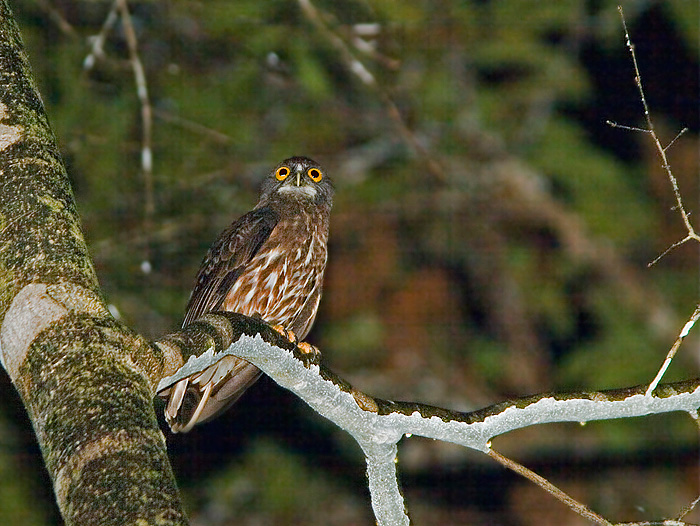
Arriving at our
forest track we kept our fingers crossed that we might be able to
locate some of the excellent species that we had seen on the first day.
Amazingly this day was almost a rerun of that success… and more! The
male Celestial Monarch performed right on cue at the selected spot,
the Philippine Dwarf Kingfisher was seen extremely well perched in the
same area (the nesting hole of these birds was found nearby shortly
after we left PICOP), we had stunning views of a male Short-crested
Monarch and the family of three Rufous Hornbills again put on a great
show. We also added some species not seen before including a
Rufous-lored Kingfisher which defied their often elusive nature by
singing from the bare branches at the top of a big tree, a delightful
group of Streaked Ground Babblers which responded well to the tape
giving excellent close views and we finally had the excellent close
views of Amethyst Brown Dove which we desired. These we just the
highlights of course and we also saw some great feeding flocks mostly
comprising species seen previous but Yellow-wattled Bulbul was
significant as our first sighting of the species on Mindanao. Our
drive through the concession again produced several perched Philippine
Falconets but also several Oriental Magpie Robins, amazingly our first
sightings of the species during the main tour. We again saw Philippine
Serpent Eagles and our first ‘Barred’ Honey-Buzzard which is
particularly significant in light of recent studies showing that the
endemic races in the Philippines are distinct from those in Indonesia
and should be treated as a separate, endemic species Steere’s
Honey-Buzzard.
Our afternoon staking our the forest clearing didn’t produce the
racquet-tails seen previously but we did see Philippine Needletails,
Philippine Pygmy Woodpecker, White-bellied Woodpecker, Greater
Flamebacks and impressive numbers of hornbills including an amazing
flock of 10 Writhed Hornbills. A flight of pigeons passing overhead in
the late afternoon included two rare Spotted Imperial Pigeons among
the commoner Green Imperial Pigeons. We finished the day with another
addition in the form of a Blue-backed Parrot heard calling as we drove
home and located perched conspicuously on top of a dead tree. In the
evening we had a particularly scrumptious meal to celebrate a
successful stay at PICOP but more importantly Stella’s birthday which
gave us a fine excuse to indulge in a particularly impressive birthday
cake!
The following morning we had just enough time for a few hours of
birding and this proved very profitable with excellent birds appearing
right up until the last moment. There were many fruiting trees which
attracted not only good numbers of Guaibero but also three
Blue-crowned Racquet-tails – a huge bonus for Max and Dan who had
missed them previously. The fruits also attracted Mindanao Hornbills,
Philippine Green Pigeons and a smart Yellow-breasted fruit Dove.
Philippine Leafbird finally appeared on cue for those who missed them
on the first day and other highlights were Black-and-White Triller,
two Silvery Kingfishers on a small river and another stunning
Azure-breasted Pitta finished our stay at PICOP in style. It was time
to take to the road again for the drive south to Davao city and a
flight back to Manila ready for the next leg of the tour.
We departed early
next morning (as always!) and made good time, arriving at Subic Bay in
time for breakfast just after dawn. Keen to begin our birding we
headed straight for a secluded area of the former military base,
exploring an intriguing network of roads which criss-cross the forest
with abandoned bunkers lining the way. Our drive produced a brief
fly-over Green Racquet-tail and rather better views of Coleto and
several Whiskered Treeswifts. A productive track into the forest was
clearly a woodpecker hot-spot and we found a single Philippine Pygmy
Woodpecker, two haematribon Greater Flamebacks, and two each
of White-bellied and Sooty Woodpeckers. Other birds were a little
quiet but we did find some Philippine Green Pigeons, Black-naped
Orioles, White-eared Brown Doves, Philippine Falconet, Red-crested
Malkoha and two additions to the main tour in the form of an elusive
Philippine Tailorbird and small groups of rather more showy Blackish
Cuckoo-shrikes calling noisily in the canopy.
A stop in a well wooded suburb on our way back into town was rewarded
with excellent close views of Luzon Hornbill, hawking Blue-throated
Bee-eaters and an unusually cooperative Colasisi perched low down in a
nearby pine tree.
Venturing out again in the afternoon, Rufous Coucals calling by the
roadside brought us to a rapid stop and we enjoyed good views of 2
groups skulking in the roadside vegetation. The stop proved even more
fortuitous when a gorgeous pair of Green Racquet-tails was brilliantly
spotted by Stella sitting quietly in a nearby tree fork and we enjoyed
quite wonderful views of these spoon-tailed parrots as they loving
preened one another.

Continuing on to the same location as the morning we found some good
numbers of Philippine Green Pigeons giving nice views in the telescope,
Luzon Hornbills, yet more raucous Blue-naped Parrots, Luzon Hawk Eagle
and a smart Chinese Goshawk which flew in and perched nearby.
Philippine Falconets were again in attendance, surveying the area from
dead snags and scanning of other tree tops found a Stripe-headed
Rhabdornis, Bar-bellied Cuckooshrike, female Black-and-White Triller
and a large flock of wintering Ashy Minivets. A single Scale-feathered
Malkoha betrayed its presence with high pitched whistled calls and was
seen loping high in the canopy.
The following morning we again made an early start with a pair of
Philippine Boobooks feeding on moths attracted to the nearby street
lamps and Philippine Scops Owls were vocal but typically elusive.
Arriving in the forest, Great-eared Nightjar hawked overhead while
Philippine Boobooks, Philippine Scops Owls and Spotted Wood
Kingfishers were again calling but remained hidden. As dawn broke and
the sun began to rise birds were all around and we found our last two
major targets at the site; firstly the distinctive fluid calls of
White-lored Orioles which were located high in the nearby trees but
later gave better views when they dropped into a nearby fruiting tree
to feed. Next up was a Luzon White-fronted Tit sat high in the bare
branches on a nearby tree which stayed just long enough for everyone
to enjoy scope views before disappearing once more. Other birds on
show during our early morning session were Philippine Falconets,
Philippine Green Pigeon, several Luzon Hornbills, White-bellied
Woodpecker, Greater Flameback, two Blackish Cuckooshrikes accompanying
the more numerous Bar-bellied Cuckooshrikes, Coleto and noisy Luzon
Balicassiao. Colasisi, Guaibero and Blue-naped Parrots all gave
colourful fly-overs and a calling Green Racquet-tail was taped in and
gave fine scope views perched overhead. After breakfast the remainder
of the day the day was taken with the long drive north through Luzon
before cutting up into the Cordillera Mountains and the Banaue town,
justly renowned for the spectacular rice terraces carved into the
nearby hillsides.
The flowing day at
Mount Polis, we arrived at dawn and spent the first few hours of
relative cool, birding the roadside down from the pass. Activity was
excellent and we were soon picking up our first endemics, mostly Luzon
Bush Warbler and Chestnut-faced Babbler but we also found a few
Green-backed Whistlers feeding quietly in the stunted montane forest.
We also saw several Island Thrushes and many Mountain Leaf Warblers,
both represented here by distinct subspecies new to us and many flocks
contained Elegant Tits, Mountain Tailorbirds, Mountain Verditer
Flycatchers, Mountain White-eyes and Metallic-winged Sunbirds. A
single Flame-breasted Fruit Dove took flight with loud wing-clapping
flights but only gave brief glimpses before disappearing back into the
forest. Continuing down the road we reached some more open grassy
areas which are home to one of the Philippines least know endemics –
the Benguet Bush Warbler. It was not long before we heard them as this
is certainly their favoured habitat, but as is typical of this family
they were particularly skulking and despite hearing at least 4 birds
over the next hour, we only managed glimpses of a single bird.
As the temperature
began to rise, bird activity along the road became slow so we headed
further down the road seeing two White’s Thrushes feeding along the
damper, shaded road verges. Continuing on, we arrived at the
picturesque village of Bay-yo nestled on the steep valley sides and
surrounded by beautifully preserved rice terraces. Here we made our
way down the steep steps below the village to arrive at the fast
flowing mountain river below. We soon found our main target – the
endemic Luzon Water-Redstart feeding on insects along the boulder
strewn river. We stayed some time here, enjoying a long lunch on the
river bank and great close views of a pair of water-redstarts as they
fed right alongside us. Also here we found a pair of Citrine Canary
Flycatchers, a Luzon Blue-headed Fantail and another White’s Thrush in
the damp overgrown fields nearby. Returning in the afternoon to the
pass we found the birding slow but excitement was provided by a nice
wintering Siberian Rubythroat and in the late afternoon we located a
nice pair of Mountain Shrikes which gave excellent views in the
perfect afternoon light. We finished the day with a confiding
Long-tailed Ground Warbler which came in to playback giving brief
glimpses as it crept mouse-like around us in the long grass.

An earlier start the following morning saw us arrive in the dark but
unfortunately none of the calling Luzon Scops Owls where close enough
to the road for us to have a chance at seeing them. Birding along the
road again produced many of the previous day’s birds including the
ubiquitous Luzon Bush Warblers and Chestnut-faced Babblers. A single
Green-backed Whistler was again located and we saw no less than four
White’s Thrushes. New birds for us were a small group of Olive-backed
Pipits feeding in the cultivated plots near the pass, a skulking
White-browed Shortwing by the roadside and best of all a group of four
White-cheeked Bullfinches.
Moving down again to the open grassy slopes we finally managed some
good views of the elusive Benguet Bush-Warbler and a Long-tailed
Ground Warbler feeding right by the roadside.
Returning again to Bay-yo for lunch the Luzon Water-Redstarts
entertained us once again and our long lunch stop here also produced
Common Kingfisher, Citrine Canary Flycatcher, Scale-feathered Malkoha
and a fly-over Crested Goshawk.
This drew to an end
this enjoyable and extremely successful main tour and the following
day some of us parted company with Leif and Dan continuing north to
finish the trip in the remote Sierra Madre Mountains as the rest of
the party returned to Manila to connect with international flights.
Philippines – Hamut camp
post-tour:
25th February – 2nd March
2007
Leader: Rob
Hutchinson
Participants: Daniel
Benders & Leif Gabrielsen

The post-tour
extension to Hamut Camp in the northern Sierra Madre Mountains of
Luzon was a great success with highlights including Flame-breasted
Frit-Dove, Grand Rhabdornis (the final member of this endemic family),
Blue-breasted Flycatcher, Luzon Striped-Babbler, Rusty-faced Babbler
and quite amazing views of the enigmatic Whiskered Pitta. Our total of
134 species included 61 endemics of which 11 were tour-exclusives.
The following day
we took advantage of our first lie-in in a month and made the
leisurely drive north to Tuguegarao accompanied by Blue-tailed
Bee-eaters, White-breasted Woodswallows and Striated Grassbirds on
roadside wires, and a surprise fly-by Island Collared Dove. The next
morning we departed early for Baliwag village on the edge of the
northern Sierra Madre Mountains disturbing a feeding Barred Rail from
the road en route. From here we set off for the trek into the
mountains, initially across the denuded foothills, albeit fortunately
in the relatively cool of the early morning. A wintering Japanese
Yellow Bunting provided some early excitement perched in a bare tree
alongside striking Coppersmith Barbets. In the open grassy hills
black-headed nasutus Long-tailed Shrikes, Paddyfield Pipits &
Black-headed Munia were numerous and we located a pair of Oriental
Skylarks. We also located a single Island Collared Dove among the
commoner Spotted Doves and a pair of Savanna Nightjars that gave great
views in flight but which we never managed to pin down on the ground.
As we approached the forest more interesting birds began to appear;
Philippine Serpent Eagles soaring overhead, fast-flying Colasisi and a
Violet Cuckoo in song flight.
Arriving in our camp at the forest edge in the late morning we took an
early lunch before heading off into the forest. The afternoon bird
activity was a little low but we added White-eared Brown-Dove, Luzon
Blue-headed Fantail, several Metallic-winged Sunbirds, Philippine
Pygmy Woodpecker and a Luzon Rufous Paradise Flycatcher glowing orange
in the undergrowth. Finally our efforts were rewarded with a smart
Furtive Flycatcher next to the trail which sang continuously but was
typically elusive, showing only occasionally. A shy Scaly Thrush was
flushed from near the trail and the distinctive calls of the rare
Sierra Madre Crow heard in the distance.
We finished with a fine pair of Rufous Hornbills which came in to
investigate our camp in the evening shortly before the Great-eared
Nightjars and Philippine Boobooks came out to play at dusk.
The following morning we awoke to calls of Spotted Wood Kingfishers,
one of which showed close to the camp. During breakfast an impressive
dawn chorus included the distinctive song of the enigmatic Whiskered
Pitta echoing from the nearby forested slopes and quickly headed off
in pursuit but we found it far away in an inaccessible area. We spent
the next few hours exploring the trail system and trying hard to find
a closer calling pitta but had to be content with some interesting
feeding flocks which included a very surprising Celestial Monarch, our
first Luzon Striped and Golden-crowned Babblers, Green-backed Whistler,
Luzon Rufous Paradise Flycatcher, Scarlet Minivets, Sulphur-billed
Nuthatch, Philippine Tailorbird and Luzon Blue-headed Fantail. A high
pitched song alerted us to the present of a Rusty-faced Babbler and
playback produced several reasonable views of a pair these large but
fast-moving babblers which are a product of the recent splitting into
two species of ‘Rabor’s Wren Babbler’. A clearing gave us great views
of Scale-feathered Malkoha and a pair of Ashy Woodpeckers before
heart-rates rose again when heading back to our camp as a Whiskered
Pitta began to call, but this time a little closer to the trail. After
just a couple of calls of playback the bird became silent and we
waiting with baited breath before the bird suddenly appeared in the
gully below us. As we waiting, silent and motionless, the bird
continued its approach until it was just a few metres from our
position and then apparently unconcerned by our close proximity, it
began to call, with each reverberating note of the song accompanied by
an elaborate bow of the head. The bird continued to perform like this
for more than half an hour, giving stunning close views and even
posing in the open on the trail beside us on occasions – these were
quite simply the best views imaginable of this rare and elusive bird,
which instantly became one of the star birds of the tour.
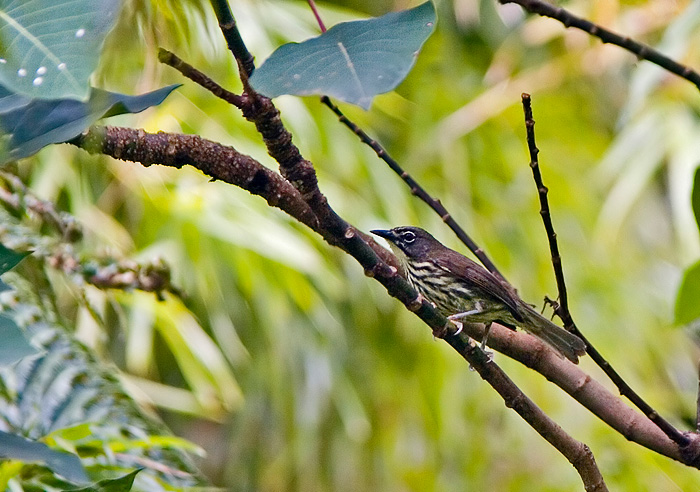
Our walk up to the
main camp was taken at a leisurely pace and was enliven by some good
birding. Several more Luzon Striped-Babblers were seen; nice views of
Blackish Cuckoo-Shrike and Philippine Fairy Bluebirds visiting a
fruiting tree, Striped Flowerpecker, Luzon Rufous Paradise Flycatcher,
single White-browed Shama and Rusty-breasted Cuckoo were also seen.
Rufous Hornbills were common and vocal and we enjoyed magnificent
views as well as a small group of smaller but equally entertaining
Luzon Hornbills. Overhead the common Philippine Serpent Eagles were
joined by 2 Oriental Honey Buzzards and a single Luzon Hawk Eagle.
A Luzon Bleeding-heart was twice flushed up from the side of the trail
before flying across the trail and landing on an open branch down the
slope below us – where is sat, nervously bobbing its head, before
flying off again down the slope.
We finished late afternoon close to the camp where fruiting rattan
attracted good numbers of White-eared Brown-Doves and we had our first
brief views of Cream-bellied Fruit-Dove.
Most of the next day was spent along the ridge trail above our camp.
Frugivores were abundant with the usual White-eared Brown-Doves
accompanied by several Amethyst Brown-Doves which are surprising
common and easy to see here compared to elsewhere in the archipelago.
We also managed good views of three Cream-bellied Fruit-Doves and two
Yellow-breasted fruit-Doves but a calling Flame-breasted Fruit-Dove
was only seen in flight and another bleeding-heart was flushed from
its hidden feeding spot in a hallow of the trail.
We also saw rather striking Philippine Fairy Bluebirds, non-descript
Blackish Cuckoo-shrikes, high speed Purple Needletails, Rusty-breasted
and Violet Cuckoo, Scale-feathered Malkohas, Bicoloured Flowerpecker,
a brief Blue-breasted Flycatcher and a very obliging White-browed
Shortwing which unusually sang from an open branch allowing us not
only to enjoy great views but also to note the very distinct
vocalisations from birds we had seen elsewhere on the tour.
In the afternoon a large feeding flock contained Stripe-headed
Rhabdornis (rather than the hoped for Grand Rhabdornis) and a brief
Ashy-breasted Flycatcher among the regular but no less enjoyable
Elegant Tits, Yellow-bellied Whistler and Sulphur-billed Nuthatches.
We finished with fantastic views of a pair of Spotted Wood Kingfishers
taped-in to super-close range near to our camp at dusk.
The following day was again spent along the highly productive ridge
trail. Several Philippine Cuckoo Doves, White-eared and Amethyst
Brown-Doves were again seen, a single Luzon Bleeding-heart was again
flushed but we did have excellent perched views of Cream-bellied
Fruit-Doves.
In the mid-morning the distinctive calls of the Sierra Madre Crow
echoed from far down the slopes and fortunately they responded
extremely well to playback by quickly flying into the nearby trees.
Here we enjoyed excellent views of this species, widely accepted as a
split from the ‘Slender-billed’ Crow complex on the grounds of
ecological and vocal differences.

Today we continued
further onto the steeper sections of the trail where Flame-breasted
Fruit-Doves were more abundant and we saw no less then seven
individuals, although good views of these shy birds were difficult and
we had several near misses before we all enjoyed prolonged and
unobscured views of an obliging individual. Today also gave our first
sightings for the extension of Philippine Trogon, Greater Flameback,
White-bellied Woodpecker and a noisy but skulking group of Rufous
Coucals.
We also had 3 encounters will Blue-breasted Flycatchers, on 2
occasions getting caught right in the middle of entertaining
territorial disputes between neighbouring pairs.
The following day dawned with low cloud and light drizzle which
encouraged a Whiskered Pitta to call very close to our camp in the
early morning. Given the less than ideal birding weather, we opted to
head slowly down the mountain rather than birding at the higher
altitudes and this proved an excellent decision. One of our first
birds was a Eurasian Woodcock on the trail ahead of us which quickly
disappeared into the surrounding vegetations – one of only a few
confirmed records of this species in the Philippines. Next were
reasonable flight views of a pair of flushed Luzon Bleeding-hearts,
before a timely breakfast break at a view point gave our first
wintering Brown-headed Thrushes and sharp eyes picked out a distant
perched Grand Rhabdornis which was joined by a second bird as they fly
close overhead, calling. The remainder of the trek gave nice views of
a shy Scaly Thrush, Philippine Trogon, Whiskered Treeswift,
Stripe-headed Rhabdornis, Citrine Canary Flycatcher, Amethyst Brown
Dove and Philippine Fairy Bluebird then Pygmy Swiftlets, Violet Cuckoo,
Pygmy and Bicoloured Flowerpeckers as we enjoyed our picnic lunch at
the forest edge.
In the afternoon we birded in the lowest patches of forest where
Philippine Drongo Cuckoo, Luzon Balicassiao and White-lored Oriole
were new to the extension. We also managed rather unsatisfactory of
Green-faced Parrotfinches, calling as the zoomed bullet-like overhead
and Plain Bush-hens called from the thick understory continuing our
frustration with this widespread but incredibly elusive endemic.
At dusk there was a chorus of Philippine Boobooks and irregular calls
of Philippine Scops Owls to accompany our dinner under star-lit skies
as Great-eared and Philippine Nightjars fed overhead.
Our final day allowed us to snatch some early morning birding time and
it proved a fitting finale with fine views of one of a pair of
Green-faced Parrotfinches in dying bamboo near the camp and nice views
of several wintering Brown-headed Thrushes. Our walk back to Baliwag
again produced flushed Savanna Nightjars but this time we were lucky
enough to relocate them for nice views on the deck as they blended
perfectly with the surrounding vegetation. A Barred Rail was seen in
flight as it disappeared into an overgrown stream, a single
Australasian Bushlark was seen and the Japanese Yellow Bunting was
again in its favoured maize field. Back to civilisation it was time
for us to return to Tuguegarao and take the short flight back to
Manila where the waiting cold San Miguel Beers were particularly
appreciated as we toasted another successful and enjoyable Philippines
adventure.
The total
for the combined five-week Philippines tour was an exceptional 167
Philippine endemics of which 162 were seen. An additional four near
endemics, with ranges extending just outside the Philippines were
recorded – Black-chinned Fruit Dove, Blue-naped Parrot, Mantanani
Scops Owl and Chocolate Boobook.
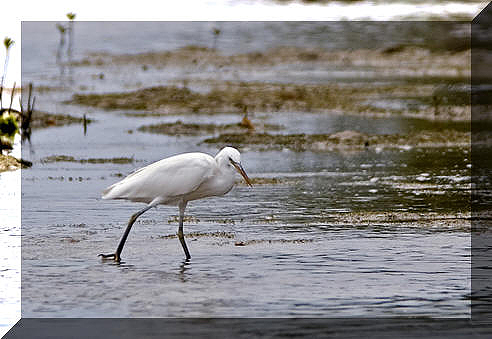
Chinese Egret (Kritthegre);
Palawan
>
Artsliste (Species list)
>
Fotogalleri (Kommer
senere)

|